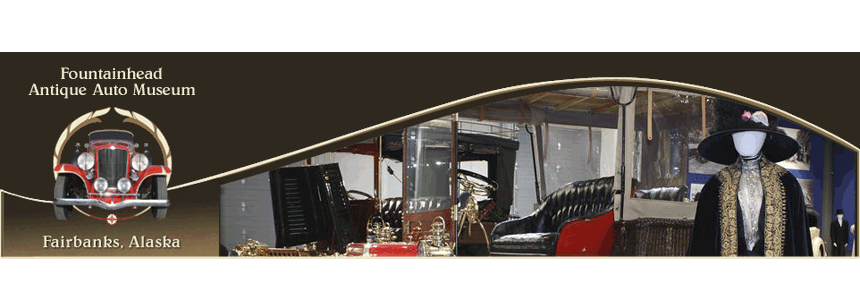 |
| Lap robe and foot warmer. A "carbon coal brick" was ignited and placed in the foot warmer's tray for heat. |
We don't have a lot of artifacts beyond cars and fashions in our museum, but visitors may have noticed a traffic light, gas pump, spark plug collection, and some displays in the video kiosks. Careful observers may have also noticed a few blankets hanging behind the front seats of several of the cars. These lap robes are carryovers from the carriage and sleigh days, and served the same purpose after the advent of the automobile; that is, something to snuggle under while riding in an open, unheated vehicle.
 Lap robes were typically made from wool, mohair, horsehair, curly silk, or alpaca. Some were made from leather or had a rubber outer layer for use in wet weather. Robes came with many different designs, ranging from solid colors and geometric patterns to flower and animal motifs. The 1912 Chase catalog alone offered more than 150 lap robe designs. In Alaska, fur-covered hides from caribou or bear were probably the warmest choice.
Lap robes were typically made from wool, mohair, horsehair, curly silk, or alpaca. Some were made from leather or had a rubber outer layer for use in wet weather. Robes came with many different designs, ranging from solid colors and geometric patterns to flower and animal motifs. The 1912 Chase catalog alone offered more than 150 lap robe designs. In Alaska, fur-covered hides from caribou or bear were probably the warmest choice. A garment rack or robe rail gave passengers a place to drape their robes and coats when not in use. Robe rails were typically made of brass, nickel, or braided cord.
A garment rack or robe rail gave passengers a place to drape their robes and coats when not in use. Robe rails were typically made of brass, nickel, or braided cord. As the automobile grew in popularity, so did the diversity of lap robe options. Some had special pockets for feet, while others had fur handmuffs sewn inside.
As the automobile grew in popularity, so did the diversity of lap robe options. Some had special pockets for feet, while others had fur handmuffs sewn inside.Some lap robes were precursors to today's "Snuggies," where the user fastened him- or herself into a custom-fitted bag. The one at right, featured in the February 1915 issue of Popular Mechanics, offered a chest protector." I'm unclear what this entailed. A built-in bra? A leather shield to protect from flying rocks? Or simply a layer of blanket worn over the chest?
 When upscale car manufacturers started giving wealthy buyers their choice of coachwork, some blanket companies began offering the option of ordering a lap robe to match or complement a car's interior.
When upscale car manufacturers started giving wealthy buyers their choice of coachwork, some blanket companies began offering the option of ordering a lap robe to match or complement a car's interior.
 Other entrepreneurs developed accessories for lap robes and rails, including locks that secured a blanket or coat to the rail (photo at left). One invention rolled a robe out of and back into a spring-loaded case, so one could pull it out like a window shade (see ad at right). Another inventor developed a child seat that attached to the robe rail. In 1929, a patent was issued for a robe rail with a removable cap on one end, allowing for an umbrella, cane, or fishing rod to be inserted for storage.
Other entrepreneurs developed accessories for lap robes and rails, including locks that secured a blanket or coat to the rail (photo at left). One invention rolled a robe out of and back into a spring-loaded case, so one could pull it out like a window shade (see ad at right). Another inventor developed a child seat that attached to the robe rail. In 1929, a patent was issued for a robe rail with a removable cap on one end, allowing for an umbrella, cane, or fishing rod to be inserted for storage.Robe rails were added to automobiles for many decades, and one can be found in one the youngest production cars we have on display, a 1934 Packard. Automobile robe rails and straps were not uncommon through the 1950s, as car heaters were wither absent or insufficient for warming the back passenger area. Although modern cars don't carry robe rails, I can tell you from experience that some Alaskans still resort to using lap blankets when riding in a car here at -40!



No comments:
Post a Comment
Blogging about the Fountainhead Antique Auto Museum's latest news, adventures and research